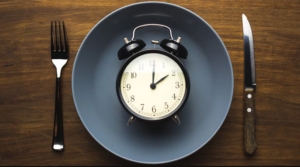Intermittent fasting is an eating pattern that includes the periods of fasting of around 12–36 hours.
Intermittent fasting may give enormous advantages if it is done well.
People can witness weight loss, metabolism boost, improve chronic health and brain health.
There are various sorts of Intermittent fasting, for example, 16/8 or 5:2 techniques. Let’s discuss them.

Fast for 16 hours each day: The 16/8 Fasting
This is a standout amongst the most widely known types of Intermittent Fasting.
In this method, You fast for 16 hours in a day and restrict your eating window for 8 hours.
Choose what part of the day is important to you. Breakfast or Dinner.
If you cannot miss dinner then skip breakfast.
If you feel energetic after having breakfast then skip Dinner.
However, Most people tend to draw out the fasting time frame in the first part of the day and have their first meal around Noon.
More than 66% intermittent faster prefer to skip their breakfast.
Now the question is, can we drink any beverages? The answer is Yes.
You can drink coffee, water, and other non-alcoholic refreshments during intermittent fasting because this is a great way to deal with your hunger cravings and lessen your appetite level.
Eating Low Carb diet in your meal can make you full for a long time and you don’t feel hungry.
Fast for 2 days per week: The 5:2 Method
5:2 Diet is also known as Fast diet.
In 5:2 diet, people eat for 5 days and fast for 2 days a week.
In eating days, People restrict their calories intakes normally around 500-600.
Usually, men intake 600 calories and women intake 500 calories.
There ought to be at least 1 non-fasting day between fasting days. For example, If you fast on Monday then Tuesday and Wednesday should be non-fasting days and then you can continue fasting on Thursday.
There are constrained research on the 5:2 eating regimen. A study including 107 overweight or fat ladies found that limiting calories a twice week by week and ceaseless calorie confinement both prompted comparative weight reduction.
Do a 24 hour Fast
It is also known as Eat Stop Eat.
In this method, People fast for 24 hours, Either once or twice per week.
Fasting from breakfast to the next breakfast count 24 hours.
You can also opt to fast from launch to launch or dinner to dinner. The consequences would be the same.
Same like 16/8 fasting, You can drink coffee, water, and other non-alcoholic refreshments to deal with hunger cravings.
On non-fasting days, you can go for a routine eating pattern. But, If you have selected this because you want to lose weight then It is recommended to eat normally and be stick to your weight loss diet plan on non-fasting days.
This type of fasting may be difficult for people.
People may deal with fatigue, headaches, or irritability during the fasting period.
It is good practice to start with 16 hours fasting before progressing to the 24-hour Fast.
Alternate Day Fasting
This type of intermittent fasting involves fasting every other day.
There are two approaches for Alternative Day Fasting. Either you can fast for the whole day, only consume water or you can limit your calories intake to 25% of your normal eating which is equivalent to 500-600 calories.
It is better not to include sugar or starch in 25% if you opt the 500 calories approach.
Alternative Day Fasting aids in weight loss and heart wellbeing as concluded by a study.
Alternate Day Fasting is the most difficult approach of fasting, and it may not be appropriate for novices or those with certain ailments.
It might be hard to keep up this sort of fasting in the long haul.
If you opt to fast for whole day approach, begin by restricting your fasts to only two days per week.
The Warrior Diet
The warrior diet method divides the 24 hours into two eating windows. 20 hours eating window and 4 hours eating window.
In 20 hours eating window, You eat the few servings of fruits and vegetables.
In 4 hours eating window, You eat a large meal at night.
If you are following some weight loss diet plan then you should eat those fruits and vegetables which are listed in your diet plan, during 20 hours eating phase.
During 4 hours eating window, Individuals should ensure that they consume a lot of vegetables, proteins, and empowering fats
It is recommended to avoid overeating late night because it slows down the digestion process and can cause stomach upset.
This eating routine can cause cancer, affect immune and digestion health if you don’t consume essential Nutrients and supplements, For Instances Fiber.
Meal Skipping: Convenient Approach
Meal skipping is a convenient and flexible approach for those who find above-mentioned approaches difficult.
As the name suggests, It includes skipping a meal occasionally or when it is convenient.
This is the perfect approach for beginners.
It is people’s choice which one they want to skip. It totally depends on their hunger level or time limitations.
it is imperative to eat healthy foods at other suppers.
There is a misconception that people need to eat at regular intervals or they’ll lose muscle or hit “starvation mode”
Dinner skipping is probably going to be best when people react to their body’s hunger cravings.
Human’s body is systemized in a way that they can live up to the three weeks without any food, allowing water in this period. So, skipping one meal or two won’t affect your health.
This approach is the simplest. People, adopting this Intermittent fasting, eat food when they have hunger craving and skip a meal when they don’t.




Comments
I do trust all the ideas you have presented for your post. They are really convincing and will definitely work. Thank you for the post.
Thanks for sharing this great post.